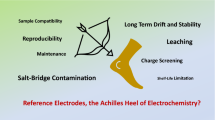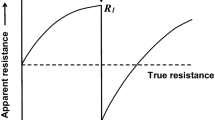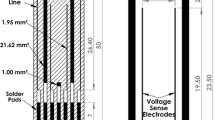Abstract
The Kelvin probe technique is a unique reference electrode that allows non-contact measurement of electrode potentials. It can be used for measuring electrode potentials through insulating dielectric media such as air or polymeric films. It is mainly used where standard electrochemical techniques, which require a finite ionic resistance between working and reference electrodes, will fail.
Access provided by Autonomous University of Puebla. Download chapter PDF
Similar content being viewed by others
Keywords
These keywords were added by machine and not by the authors. This process is experimental and the keywords may be updated as the learning algorithm improves.
The Kelvin probe technique is a unique reference electrode that allows non-contact measurement of electrode potentials. It can be used for measuring electrode potentials through insulating dielectric media such as air or polymeric films. It is mainly used where standard electrochemical techniques, which require a finite ionic resistance between working and reference electrodes, will fail.
It was invented by W. Thomson [1], the later Lord Kelvin, and was originally only used for measuring work functions of materials. In the classical set-up sample surface and the Kelvin probe plate form a parallel plate capacitor. If the capacitance between probe plate and sample surface is known, the work function difference between probe (reference material) and sample can be calculated, although the measurement of the charge is not easily performed. This problem can be overcome by measuring the discharge current when the distance between probe and sample is varied [1, 2], first introduced by Lord Kelvin. Zisman developed the technique further to the vibrating capacitor technique, in which the probe plate vibrates periodically, thus causing a steady ac current to flow [3]. Nowadays the vibrating capacitor set-up is the established technique for Kelvin probe.
While the Kelvin probe is widely used in surface physics to study adsorption of molecules or reconstruction processes of single crystal surfaces (see e.g. [4]), which both cause a change in the surface or dipole potential, its application in electrochemistry is quite recent. As it is the only reliable reference electrode that can be applied to electrodes covered by ultrathin electrolyte layers, a common situation in atmospheric corrosion, it was first applied for electrochemical studies in corrosion science. Stratmann et al. [5–14] were the first who used a Kelvin probe as reference electrode.
Using the Kelvin probe as reference electrode is directly related to measuring absolute electrode potentials. The concept of absolute electrode potentials dates back to the first works on the relationship between potential at zero charge and work function of a metal. Veselovsky [15] pointed out that the difference between the zero charge potentials for silver and mercury electrodes is virtually equal to the difference between the work functions of these metals. According to Grahame [16] Frumkin expressed similar ideas more than 80 years ago [17].
This discussion about an “absolute” electrode potential, referenced like the work function against the vacuum level, experienced a revival in the 1970s by Bockris et al. [18–20] and Gileadi [21]. However, it was essentially S. Trasatti who formed the modern concept of absolute electrode potential [22–28]. The following discussion (see also [29]) is mainly inspired by his ideas published in [27].
Firstly, it is helpful to consider the definition of the work function.
The work function is defined as the minimum work that is required to extract an electron from within the sample to a position just outside the sample (far enough to avoid contributions from image forces). It is comprised of the chemical work and the electrostatic work necessary for transporting the charged electron through the dipole layer at the surface:
where μ e is the chemical potential (i.e. the chemical work to transfer the electron from the infinity into the sample and hence the minus sign) and χ is the so-called dipole or surface potential. This is the potential drop between just inside the sample and just outside of it.
The use of the phrase “just outside the sample” for the definition of the work function is unimportant for the case of an uncharged sample, where the energetic position just outside the sample is the same as far away from it, i.e. it is equivalent with the vacuum level. But usually the sample is charged and then an additional work component is required to transfer the electron from just outside the surface to a position infinitely far away: e⋅ψ, where ψ is the Volta potential, which is equivalent for the potential drop from the infinity to a position just outside the surface. The Volta potential is due to surface charges; see Fig. 15.1.
The work function is defined as the minimum work that is required for the removal of an electron from within the sample to a point just outside the sample (a). For uncharged samples the energy level at this position is equivalent to the vacuum level E*vac = E vac (b). For charged samples with the external potential ψ ≠ 0 this is still −e⋅ψ away from the absolute vacuum level E vac (c). M denotes the metal, and A and B positions inside the metal and just outside of it
The dipole potential χ and the Volta potential ψ sum up to the Galvani potential φ, i.e., the potential drop between the vacuum level infinitely far away from the surface and the bulk of the sample:
Now also for this case the work for transferring an electron from the bulk just outside the electrolyte layer can be defined, which can be considered as a kind of modified work function Φ*, describing the minimum work to extract an electron from the Fermi level, through the solid/liquid interface (with the potential drop \( \Delta \phi_{\mathrm{ M}}^{\mathrm{ El}} \)), through the liquid and through the surface layer of the liquid to a position just outside the liquid; see Fig. 15.2a, b. Then the quantity E abs = Φ*/e is defined as the absolute electrode potential of a sample covered by an electrolyte layer.
A more general work function Φ* may be defined, in analogy to the definition of the work function, where the electron is also transferred through the electrolyte layer covering the sample [see (b)]. The absolute electrode potential is then defined as E abs = Φ*/e. (c) Both paths AC and ABC for the electron extraction are energetically equivalent. M and El denote the metal and the electrolyte layer, respectively. A a position inside the metal, B a position just outside of it and C a position just outside the electrolyte layer
Hence, \( {E_{\mathrm{ abs}}}=\Phi^*/e \) is directly obtained from Eq. (15.1) by adding the additional term \( \Delta {\varphi_{\mathrm{ M}}}^{\mathrm{ El}}={\varphi_{\mathrm{ M}}}-{\varphi_{\mathrm{ El}}} \) and exchanging χ El with χ M:
where \( \Delta \varphi_{\mathrm{ M}}^{\mathrm{ El}} \) is the potential drop at the metal/liquid interface and \( {\chi_{\mathrm{ El}}} \) the surface potential of the electrolyte layer.
On the other hand, the absolute potential can also be expressed by the work function of the metal and the Volta potential difference between metal and electrolyte (see Fig. 15.2c):
where ψ M and ψ El denote the Volta potentials outside the metal and outside the solution.
If now a metallic probe KP is positioned near the surface of the electrolyte, thus as sketched in Fig. 15.3, then the following correlation can be made:
The work for transferring an electron from within the metal M to a point over the surface of the electrolyte is the same for all three indicated transfer paths, and hence, \( {E_{\mathrm{ abs}}}=\frac{1}{e}\varPhi ^*=\left( {-\frac{{{\mu_{\mathrm{ e}}}}}{e}+\Delta \varphi_{\mathrm{ M}}^{\mathrm{ El}}+\chi {}_{\mathrm{ El}}} \right)={\Phi^{\mathrm{ M}}}/e+({\psi^{\mathrm{ M}}}-{\psi^{\mathrm{ El}}})={\Phi^{\mathrm{ KP}}}/e+({\psi^{\mathrm{ KP}}}-{\psi^{\mathrm{ El}}}). \) Hence, the Volta potential difference between the Kelvin probe and the electrolyte surface is directly correlated to the electrode potential of the immersed electrode M
as no work is required for an electron to go from the metal M into the also metallic probe KP.
If the work function of the probe KP is known, the absolute electrode potential can be directly obtained by the measurement of the Volta potential difference (ψ KP − ψ El). This potential difference is exactly what the Kelvin probe technique provides. The bottom of the tip of the Kelvin probe and the surface of the electrolyte just beneath it form a plate capacitor which is charged due to the bias ψ KP − ψ El across the gap between tip and electrolyte. When the tip vibrates periodically over the electrolyte layer, such that the distance is modulated periodically, this induces a so-called displacement current. This current can be nulled by applying an external bias compensating ψ KP − ψ El. This way this Volta potential differences can be easily obtained; for more details, see e.g. [29, 30]. In this way the Kelvin probe technique may be described as the natural reference electrode, which has the great advantage of being very versatile in application.
The absolute electrode potential can be easily correlated to the conventional reference electrodes as usually applied in electrochemistry. For instance for the correlation of the absolute electrode potential with the electrode potential referenced vs. the standard hydrogen electrode, we can simply write as follows:
where \( E^{\rlap{-}{\mathrm{ o}}}\) (SHE)abs is the potential of the standard hydrogen electrode in the absolute electrode potential scale.
Obviously, the following correlation between the potential of zero charge and the corresponding modified work function Φ* measured on the electrolyte-covered metal at the potential of zero charge can be made [27]:
i.e., the measurement of the corresponding modified work function Φ* provides directly \({E^{{\rlap{-}{\mathrm{ o}}}}}\)(SHE)abs, if the potential of zero charge vs. SHE is known. Unfortunately, as it is difficult in ambient environment to make a really precise measurement of the work function of the Kelvin probe, these measurements are not easy. Hence, the values found in the literature scatter in a wide range from about 4.44 to 4.85 V [27].
For this reason it is usually not used for measuring electrode potentials in the absolute potential scale, but it is referenced vs. a standard reference electrode as they are commonly used in electrochemistry. For this a simple calibration has to be carried out.
As the absolute electrode potential E abs is correlated with the corresponding electrode potential vs. a given reference through the relation \( {E_{\mathrm{ ref}}}={E_{\mathrm{ abs}}}-E{{(\mathrm{ ref})}_{\mathrm{ abs}}} \), we can write [see Eq. (15.5)]:
Since E(ref)abs and Φ KP are constant, we can directly write as follows:
where the constant depends on the chosen standard reference electrode.
The value for const(ref) can be obtained by calibrating the Kelvin probe by means of a suitable reference system, as e.g. copper in a Cu2+-containing electrolyte or zinc in Zn2+-containing electrolyte (i.e. vs. Cu/Cu2+ or Zn/Zn2+), or by direct calibration vs. an electrode polarised potentiostatically to different potentials, such as schematically depicted in Fig. 15.4.
Left: A very instructive way for calibrating the Kelvin probe is by positioning it over an electrolyte-covered surface potentiostatically polarised to different potentials. A typical calibration curve is shown on the right. As can be seen, there is a linear relation between measured Kelvin probe signal and the applied electrode potential. Once the correct functioning of an SKP set-up has been checked this way, it is sufficient to calibrate the offset value (here it is about 400 mV) with just one measurement vs. a reference. This is usually done by positioning the SKP over a small Cu beaker filled with CuSO4 solution of well-known concentration (usually saturated) and referencing the SKP signal to the corresponding Cu/Cu2+ potential [31]
From the example shown in Fig. 15.4 it becomes obvious that through the application of the Kelvin probe an active potentiostatic control of surfaces covered by ultrathin electrolyte layers should be possible and hence performing electrochemical experiments on such samples, which is of great significance for fundamental studies of atmospheric corrosion [9] and for catalysis, e.g., in fuel cells and modern high rate electrolytical processes where high transport rates are achieved by ultrathin electrolyte layers (as of importance e.g. for modern chloralkali electrolysis [32]).
For such electrochemical experiments under ultrathin electrolyte layers usually a set-up as shown in Fig. 15.5 is used.
Schematic cross section of a typical set-up for performing electrochemical experiments under ultrathin electrolyte layers. The working electrode is made of a cylinder that is, together with the counter electrode ring positioned around it, embedded in an inert and insulating polymer, e.g. in epoxy. The Kelvin probe tip is positioned over the centre of exposed surface of the working electrode. This way Ohmic drops during polarisation can be minimised
With such a set-up it was found, for instance, that the rate-determining step for oxygen reduction on a sufficiently cathodically polarised platinum electrode underneath an ultrathin electrolyte layer below a certain thickness ceases to be the diffusion through it and starts to be controlled by the oxygen uptake at the electrolyte surface (see Fig. 15.6).
Dependence of the rate of the oxygen reduction on the thickness of the electrolyte layer; Pt, 1 M Na2SO4, E = −0.65 VSHE (rate plotted vs. 1/d; dashed line: slope that can be used to calculate the diffusion coefficient of oxygen; dotted line is indicating the likely further behaviour of the oxygen reduction rate; see [9])
Even “dry” surface under typically ambient conditions can be considered as electrodes where it makes sense to interpret the work functions measured on these surfaces as electrode potentials, as these are directly related to the electrochemical activity on these surfaces [33].
Other than for electrodes immersed in bulk electrolyte, on electrodes covered by ultrathin layers the electrode potential may differ significantly across the electrode surface. Hence, localised measurements are of interest, being performed by scanning the tip across the sample. This was first applied for organic coated metals where the coating was electrochemically delaminating, driven by corrosion [12–14, 29]. Even on the submicron scale the Kelvin probe technique can be applied for such studies, and then based on a modified atomic force microscope, see [34, 35]. Recent developments are the combination of Kelvin probe and SECM [36] and the use of Kelvin probe for hydrogen detection [37].
References
Thomson W (1898) Philos Mag 46:82
Patai IF, Pomerantz MA (1951) J Franklin Inst 252:239
Zisman WA (1932) Rev Sci Instrum 3:367
Rohwerder M, Benndorf C (1993) Surf Sci 307–309:789
Stratmann M, Kim KT, Streckel H (1990) Z Metallkunde 81:715
Yee S, Stratmann M, Oriani RA (1991) J Electrochem Soc 138:55
Stratmann M, Streckel H (1990) Corr Sci 30:681
Stratmann M, Streckel H (1990) Corr Sci 30:697
Stratmann M, Streckel H, Kim KT, Crockett S (1990) Corr Sci 30:715
Leng A, Stratmann M (1993) Corr Sci 34:1657
Stratmann M (1992) Bull Electrochem 8:30
Leng A, Streckel H, Stratmann M (1999) Corr Sci 41:547
Leng A, Streckel H, Stratmann M (1999) Corr Sci 41:579
Leng A, Streckel H, Hofmann K, Stratmann M (1999) Corr Sci 41:599
Veselovsky VJ (1939) Acta Physicochim URSS 11:815
Grahame DC (1947) Chem Revs 41:441
Frumkin AN (1930) Colloid Symposium Annual 7: 89
Bockris JOM, Argade SD (1968) J Chem Phys 49:5133
Bockris JOM (1970) Energ Conv 10:41
Bockris JOM (1972) J Electroanal Chem 36:495
Gileadi E, Stoner G (1972) J Electronal Chem 36:492
Trasatti S, Damaskin B (1974) J Electroanal Chem 52:313
Trasatti S (1975) J Electroanal Chem 66:155
De Battisti A, Trasatti S (1977) J Electroanal Chem 79:251
Trasatti S (1982) J Electroanal Chem 139:1
Trasatti S (1990) Electrochim Acta 3:269
Trasatti S (1991) Electrochim Acta 36:1659
Trasatti S (1995) Surf Sci 335:1
Rohwerder M, Turcu F (2007) Electrochim Acta 53:290
Frankel GS, Stratmann M, Rohwerder M, Michalik A, Maier B, Doora J, Wicinski M (2007) Corr Sci 49:2021
Ehahoun H, Stratmann M, Rohwerder M (2005) Electrochim Acta 50:2667
Jörissen J, Turek T, Weber R (2011) Chem unserer Zeit 5:172
Hausbrand R, Stratmann M, Rohwerder M (2008) J Electrochem Soc 155:C369
Rohwerder M, Hornung E, Stratmann M (2003) Electrochim Acta 48:1235
Senöz S, Rohwerder M (2011) Electrochim Acta 56:9588
Senöz S, Maljusch A, Rohwerder M, Schuhmann W (2012) Electroanalysis 24:239
Senöz S, Evers S, Stratmann M, Rohwerder M (2011) Electrochem Commun 13:1542
Author information
Authors and Affiliations
Corresponding author
Editor information
Editors and Affiliations
Rights and permissions
Copyright information
© 2013 Springer-Verlag Berlin Heidelberg
About this chapter
Cite this chapter
Rohwerder, M. (2013). The Kelvin Probe Technique as Reference Electrode for Application on Thin and Ultrathin Electrolyte Films. In: Inzelt, G., Lewenstam, A., Scholz, F. (eds) Handbook of Reference Electrodes. Springer, Berlin, Heidelberg. https://doi.org/10.1007/978-3-642-36188-3_15
Download citation
DOI: https://doi.org/10.1007/978-3-642-36188-3_15
Published:
Publisher Name: Springer, Berlin, Heidelberg
Print ISBN: 978-3-642-36187-6
Online ISBN: 978-3-642-36188-3
eBook Packages: Chemistry and Materials ScienceChemistry and Material Science (R0)










